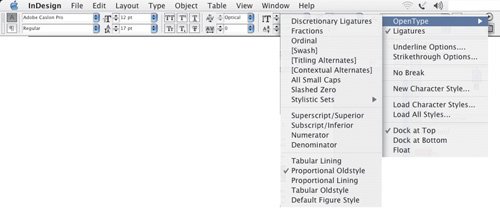OpenType: The New Frontier in Font Technology
OpenType The New Frontier in Font Technology
BACK IN THE TWENTIETH CENTURY when PostScript fonts battled it out with TrueType fonts in what the trade press dubbed "font wars," managing fonts was a thorn in the side of every graphic designer. With PostScript fonts you had to keep track of the two parts of your font: a screen font, which contained the information about the font's spacing characteristics and kerning pairs, and a printer or outline font, which contained the data about each character shape. It was this second part that was downloaded to your PostScript printer so it could print the characters. TrueType fonts were simpler in that there was only one part to them, but too often caused problems when printing to a PostScript imagesetter.
Note
A short-lived solution to the shortcomings of Type 1 Postscript fonts was the Multiple master, which allowed the user to generate different weights and widths of the typeface from a small number of master outlines. But Multiple masters didn't catch on, mainly because they were expensive and confusing. Names like MyriadMM 215LT didn't exactly roll off the tongue. Multiple masters were discontinued in 2001, though they still pop up in font menus.
Figure 7.1. The OpenType menu. Features not supported in the current font appear in square brackets, such as [Swash].

Today, on the Mac, Type 1 PostScript fonts continue to abound, and on the Windows platform, there are still plenty of TrueType fonts. However both formats are being superseded by OpenType fonts (Adobe released its whole type library in the OpenType format in 2003). OpenType is a cross-platform standard developed by Adobe and Microsoft. There are no compatibility headaches going from Mac to Windows, or visa versa, and there's only one file to manage. What makes OpenType fonts so compelling, though, is their massively expanded character set. With room for so many more characters, OpenType fonts include the full range of Latin characters used in the Western world. Others add a full range of accented characters to support central and eastern European languages, such as Turkish and Polish. Some OpenType Pro fonts also contain Cyrillic and Greek characters. In addition to making multilingual typography easier, OpenType fonts give us all kinds of typographic delicacies that we formerly had to switch to an "Expert Set" in order to access. Let's take a look at what we've got:
Ligatures |
Part I: Character Formats
Getting Started
- Getting Started
- An InDesign Type Map: Where to Find Stuff
- Viewing Your Page
- Creating a Typography Workspace
- Up Next
Going with the Flow
- Going with the Flow
- A Blank Sheet: Typing on Your Page
- Text Flow
- Threading Text Frames
- Using Placeholder Text
- Pasting Text
- Importing Word Text
- Up Next
Character Reference
- Character Reference
- Less is More, Maybe
- Type Anatomy
- Type Classification
- Character Formatting Options
- Readability
- Up Next
Getting the Lead Out
- Getting the Lead Out
- How Much Is Enough?
- (Not) Using Auto Leading
- Keep It Consistent, Except. . .
- Leading Menu Options and Keyboard Shortcuts
- See Also
- Up Next
Kern, Baby, Kern
- Kern, Baby, Kern
- When to Kern
- Metrics Kerning
- Optical Kerning
- Manual Kerning
- How Much to Kern
- Tracking
- When to Track
- Controlling Widows and Orphans
- Up Next
Sweating the Small Stuff: Special Characters, White Space, and Glyphs
- Sweating the Small Stuff: Special Characters, White Space, and Glyphs
- Typographers Quotes
- Apostrophes
- Dashes
- Ellipses
- End Marks
- White Space Characters
- The Glyphs Palette
- Footnotes
- Footnote Options
- Up Next
OpenType: The New Frontier in Font Technology
- OpenType: The New Frontier in Font Technology
- Ligatures
- Discretionary Ligatures
- Ordinals/Raised and Lowered Characters
- Swash Characters
- Fractions
- Oldstyle Figures
- Contextual Alternates
- Opticals
- Glyph Positioning
- Stylistic Sets
- Up Next
Part II: Paragraph Formats
Aligning Your Type
- Aligning Your Type
- Centering Type
- Clean Shaven or Rugged: Justified vs. Ragged Type
- How InDesign Justifies Type
- Balancing Ragged Lines
- Right-Aligned Type
- Optical Margin Alignment
- Indent to Here
- Vertical Alignment
- Up Next
Paragraph Indents and Spacing
First Impressions: Creating Great Opening Paragraphs
- First Impressions: Creating Great Opening Paragraphs
- Creating a Simple Drop Cap
- Drop Cap Aesthetics
- Tricks with Drop Caps
- Up Next
Dont Fear the Hyphen
Mastering Tabs and Tables
- Mastering Tabs and Tables
- Setting Tabs
- Creating Decimal Tabs
- Using Tab Leaders
- Reply Forms
- Numbered Lists
- Right Indent Tab
- Working with Tables
- Creating a Table
- Working with Rows and Columns
- Working with Table Cells
- Up Next
Part III: Styles
Stylin with Paragraph and Character Styles
- Stylin with Paragraph and Character Styles
- Creating Styles
- Applying Styles
- Editing Styles
- Redefining Styles
- Creating Default Styles
- A Typical Style Sheet
- Up Next
Mo Style
Part IV: Page Layout
Setting Up Your Document
- Setting Up Your Document
- Choosing a Page Size
- Determining Margins
- Determining Column Width
- Changing Columns
- Break Characters
- Page Numbers
- Section Markers
- Up Next
Everything in Its Right Place: Using Grids
- Everything in Its Right Place: Using Grids
- Things to Consider
- Your Grid Tool Kit
- Calculating the Height of the Type Area
- Align to Grid
- First Baseline Options
- Snap to Guides
- Up Next
Text Wraps: The Good, the Bad, and the Ugly
- Text Wraps: The Good, the Bad, and the Ugly
- Applying Text Wraps
- Wrapping Type Around Irregularly Shaped Graphics
- Text Wrap Preferences
- Ignoring Text Wrap
- Anchored Objects
- Up Next
Type Effects
EAN: 2147483647
Pages: 186
